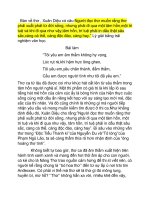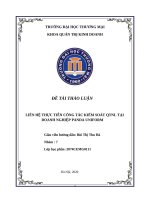a0002 a laboratory course in c plus plus data structure morebook vn 1394
Bạn đang xem bản rút gọn của tài liệu. Xem và tải ngay bản đầy đủ của tài liệu tại đây (8.01 MB, 7 trang )
A Laboratory Course in
C
++
Data
Structures
James Robergé
Stefan Brandle
David Whittington
Second Edition
JONES AND BARTLETT COMPUTER SCIENCE
A Laboratory Course in
Second Edition
C
++
Data
Structures
James Robergé
Illinois Institute of Technology
Stefan Brandle
Taylor University
David Whittington
Taylor University
World Headquarters
Jones and Bartlett Publishers
40 Tall Pine Drive
Sudbury, MA 01776
978-443-5000
www.jbpub.com
Jones and Bartlett Publishers
Canada
2406 Nikanna Road
Mississauga, ON L5C 2W6
CANADA
Jones and Bartlett Publishers
International
Barb House, Barb Mews
London W6 7PA
UK
Copyright © 2003 by Jones and Bartlett Publishers, Inc.
Cover image © Douglas E. Walker / Masterfile
All rights reserved. No part of the material protected by this copyright notice may be reproduced or utilized
in any form, electronic or mechanical, including photocopying, recording, or any information storage or
retrieval system, without written permission from the copyright owner.
Library of Congress Cataloging-in-Publication Data
Robergé, Jim.
A laboratory course in C++ data structures / James Robergé, Stefan Brandle, David Whittington.
p. cm.
ISBN 0-7637-1976-5
1. C++ (Computer program language) I. Brandle, Stefan. II. Whittington, David. III.
Title.
QA76.73.C153R58 2003
005.13’3—dc21
2002044401
Editor-in-Chief, College: J. Michael Stranz
Production Manager: Amy Rose
Associate Editor: Theresa DiDonato
Associate Production Editor: Karen C. Ferreira
Production Assistant: Jenny L. McIsaac
Senior Marketing Manager: Nathan J. Schultz
Composition: Northeast Compositors
Cover Design: Night & Day Design
Manufacturing Buyer: Therese Bräuer
Printing and Binding: Courier Stoughton
Cover Printing: Courier Stoughton
Printed in the United States of America
07 06 05 04 03
10 9 8 7 6 5 4 3 2 1
To my son Edward, who lets me see a world of wonder through his eyes.
And to my wife, Ruby, who creates that world.
—James Robergé
To Christina, Anna, and Esther: my queen and little princesses.
—Stefan Brandle
In memory of my kitty Sweetpea.
—David Whittington
Pointers
• int * ptr
Just for completeness, ptr is a pointer to integer. Both
the data pointed at and where the pointer points can be
modified.
It is good software engineering practice to give a function only as much access to
data as it absolutely needs. The results are more complicated-looking code, but it can
save tons of time that otherwise would be spent debugging to determine how and
where something was getting magically changed. So if a function uses an array but
doesn’t need to change the data, it would be best passed as const type * ptr, or
even const type * const ptr.
Pointer math: Pointers can be incremented (++) and decremented (--), integers
can be added or subtracted from pointers ( +, +=, —, -=) or one pointer may be
subtracted from another. The general rule to remember is that the arithmetic is always
done in terms of the size of the data type pointed at. For example, ptr += 2 means
“change what we are pointing at by 2 * sizeof the data type”; if the datatype is 8 bytes,
then ptr now points 2 * 8 = 16 bytes higher. ptr2 — ptr1 gives you the difference
between the two pointers as a difference between the array index value of ptr2 and
ptr1, so if ptr2 points to array[3] and ptr1 points to array[1], ptr2 — ptr1 =
2 (since the ptr2 points to an element two elements away from ptr1). Pointer math
only makes sense in the context of an array.
C-Strings: C-strings are just pointers to an array of characters. The string end is
calculated by starting at item 0 in the array and moving up through the indexed
characters until a character with the value ‘\0’ is found; that is the end of the string.
Note: There is a big difference between an empty string (the first item in the array has
the value ‘\0’) and a null string (the pointer has the value NULL, or (char *) 0). A
NULL pointer by our definition doesn’t point at any data.
|
411


